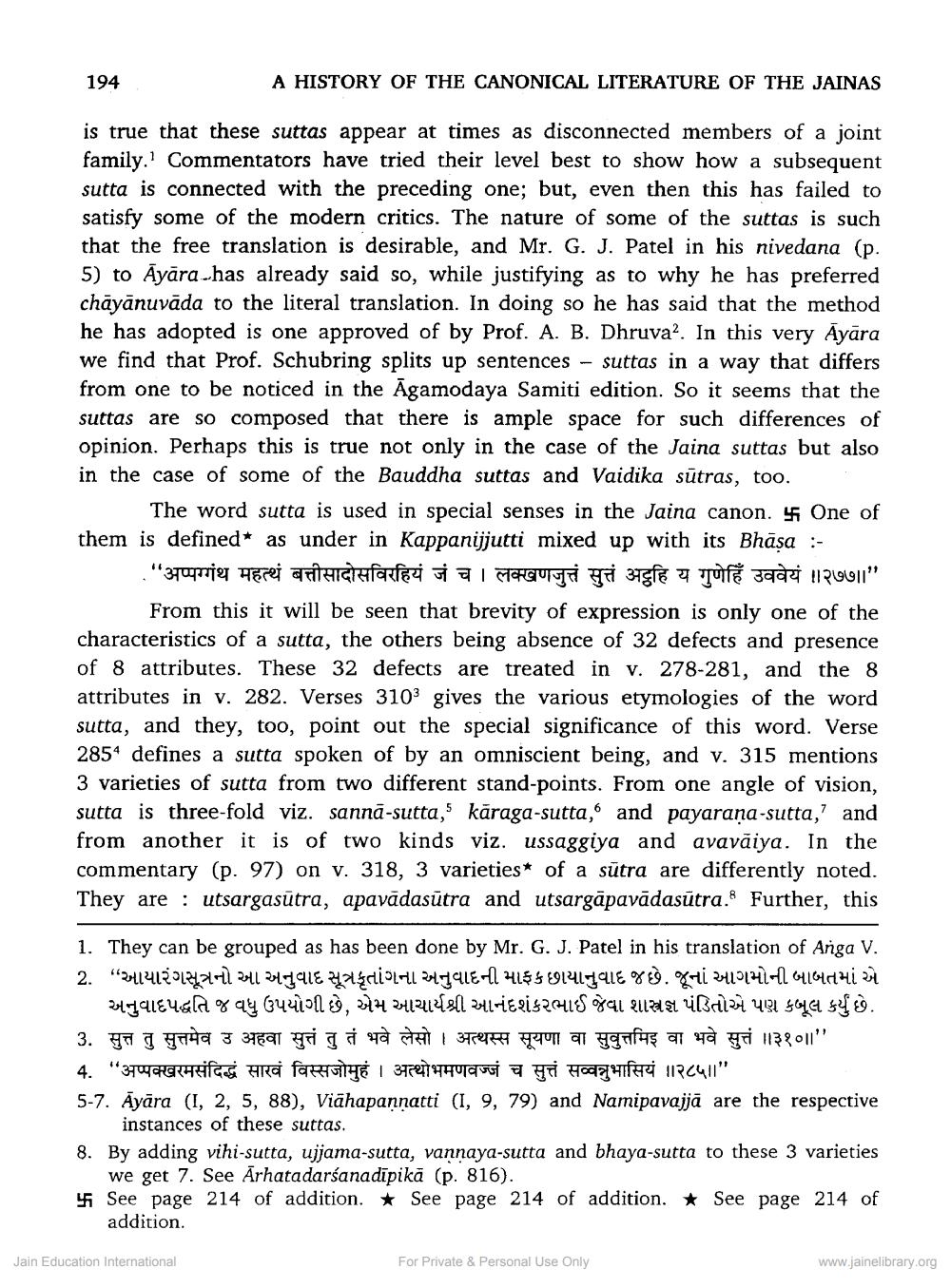________________
A HISTORY OF THE CANONICAL LITERATURE OF THE JAINAS
is true that these suttas appear at times as disconnected members of a joint family.' Commentators have tried their level best to show how a subsequent sutta is connected with the preceding one; but, even then this has failed to satisfy some of the modern critics. The nature of some of the suttas is such that the free translation is desirable, and Mr. G. J. Patel in his nivedana (p. 5) to Ayara has already said so, while justifying as to why he has preferred chāyānuvāda to the literal translation. In doing so he has said that the method he has adopted is one approved of by Prof. A. B. Dhruva2. In this very Ayara we find that Prof. Schubring splits up sentences - suttas in a way that differs from one to be noticed in the Agamodaya Samiti edition. So it seems that the suttas are so composed that there is ample space for such differences of opinion. Perhaps this is true not only in the case of the Jaina suttas but also in the case of some of the Bauddha suttas and Vaidika sutras, too.
194
The word sutta is used in special senses in the Jaina canon. One of them is defined as under in Kappanijjutti mixed up with its Bhasa :
"अप्परगंध महत्थं बत्तीसादोसविरहियं जं च लक्खणजुत्तं सुतं अहि य गुणेहिं उववेयं ॥ २७७॥"
From this it will be seen that brevity of expression is only one of the characteristics of a sutta, the others being absence of 32 defects and presence of 8 attributes. These 32 defects are treated in v. 278-281, and the 8 attributes in v. 282. Verses 3103 gives the various etymologies of the word sutta, and they, too, point out the special significance of this word. Verse 285 defines a sutta spoken of by an omniscient being, and v. 315 mentions 3 varieties of sutta from two different stand-points. From one angle of vision, sutta is three-fold viz. sannā-sutta, kāraga-sutta, and payaraṇa-sutta,' and from another it is of two kinds viz. ussaggiya and avaväiya. In the commentary (p. 97) on v. 318, 3 varieties* of a sutra are differently noted. They are utsargasutra, apavadasutra and utsargāpavadasutra. Further, this
1. They can be grouped as has been done by Mr. G. J. Patel in his translation of Arga V. 2. “આયારંગસૂત્રનો આ અનુવાદ સૂત્રકૃતાંગના અનુવાદની માફક છાયાનુવાદ જછે. જૂનાં આગમોની બાબતમાં એ અનુવાદપદ્ધતિ જ વધુ ઉપયોગી છે, એમ આચાર્યશ્રી આનંદશંકરભાઈ જેવા શાસ્ત્રજ્ઞ પંડિતોએ પણ કબૂલ કર્યું છે. 3. सुत्त तु सुत्तमेव उ अहवा सुत्तं तु तं भवे लेसो अत्थस्स सूयणा वा सुवुत्तमिइ वा भवे सुत्तं ॥ ३१०||" 4. "अप्पक्खरमसंदिद्धं सारखं विस्सजोमुहं । अत्थोभमणवज्जं च सुत्तं सव्वन्नुभासियं ॥ २८५॥"
5-7. Ayara (1, 2, 5, 88), Viahapannatti (1, 9, 79) and Namipavajjä are the respective instances of these suttas.
8. By adding vihi-sutta, ujjama-sutta, vannaya-sutta and bhaya-sutta to these 3 varieties we get 7. See Arhatadarśanadipikā (p. 816).
See page 214 of addition. See page 214 of addition. See page 214 of addition.
Jain Education International
For Private & Personal Use Only
www.jainelibrary.org




